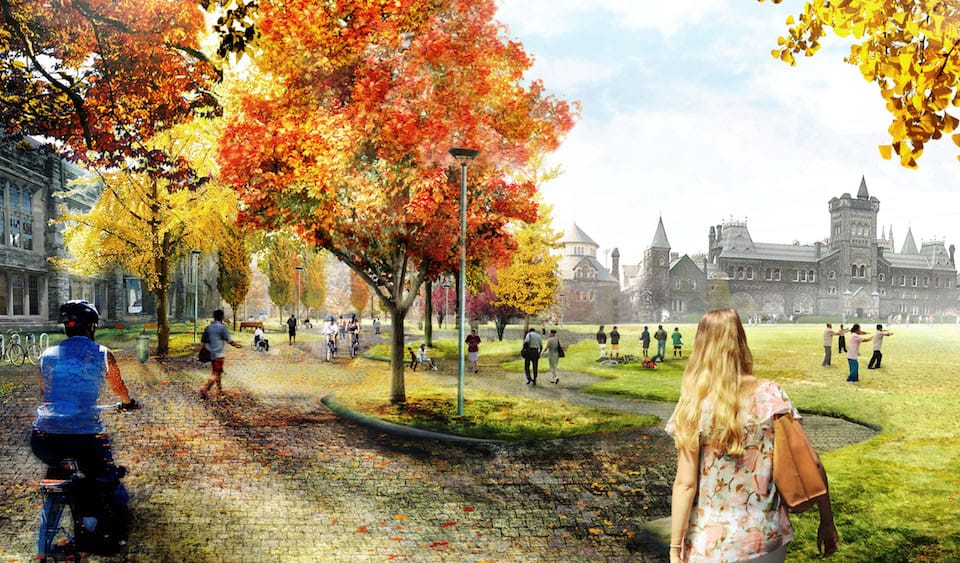[dropcap]According[/dropcap] to the architects and planners bidding for a potential UTSG revitalization contract, one of the primary factors holding us back from enjoying our campus is that King’s College circle is not actually a perfect circle. According to one group, investing money into normalizing King’s College Circle would be to ensure that the space symbolizes “complete democracy” and “unity” across campus.
This was one of many less than insightful suggestions presented in mid-September as part of the university’s ‘Innovative Ideas and Design’ competition for the revitalization of major public spaces at UTSG. Other proposed changes included: digging under King’s College Circle to carve out an underground parking space; creating a pond in front of Hart House to commemorate Taddle Creek (the buried waterway upon which Philosopher’s Walk is now located); and tilting King’s College Circle so that it sits on an angle.
In addition to avoiding the practical question of how much this will cost, the proposals to transform U of T into a “grand,” “ceremonious,” pedestrian-friendly space fall short of their goals to reclaim the space for students and to showcase the heritage of U of T’s land. The PowerPoint slides that feature images of fit white students enjoying the newly revitalized spaces failed to address exactly whose heritage these proposals are attempting to preserve.
[pullquote]Pedestrian-friendly space fall short of their goals to reclaim the space for students and to showcase the heritage of U of T’s land[/pullquote]
We argue that the projects perpetuate an identity based on social exclusion. Take, for instance, how the presentations consistently emphasized a commitment to preserving the “memory of tradition” at U of T. While “heritage trees,” “indigenous plants,” and “indigenous granite tradition” were cited in the presentations as examples of motifs from the past. Yet, noticeably absent from this history was any acknowledgement of the Indigenous presence, activity, or usage of the land upon which U of T was built. The theme of creating and maintaining a “dignified space” at U of T was demonstrated using photos from the 1890’s; these photos of uninhabited land and buggies driven by men in top hats were meant to reflect the history of Taddle Creek, but these presentations neglected to mention that the ravine was the primary place for the Anishinabek to fish for salmon and trout.
Images like these invoke the colonial notion of terra nullius: the idea that the land our university was built upon was empty and thus ripe for the taking. If we are set on preserving and respecting motifs of the past, then what is missing from all four proposals is an examination of the rich, layered history of the land upon which U of T now stands, as well as accounts of the diverse people and purposes it serves.
These projects are part of a greater dialogue about the institutional erasure of history. For example, students often forget that the university’s “heritage” included its identity as a space only accessible to bourgeois white men. Students often refer to University College’s quad with a sense of pride by recalling its connection to Sir Daniel Wilson, the university’s president from 1889 to 1892. What many of us seem to have forgotten is that Sir Wilson desired to keep young women out of the institution for fear of ‘distracting’ male students from their studies. A dignified space during his tenure, then, was a space where young women were socially excluded. This is certainly a part of the university’s history that we should not be promoting today.
If the design competition’s goal is to commemorate the traditions of the land, it only succeeds in commemorating a linear, colonial, masculine history, at the expense of excluding and erasing any others. If U of T truly strives for “unity” and promotion of “democracy”, then spending thousands on normalizing King’s College Circle into a perfect circle is not the solution. It must address the more significant structural, social, and political barriers that students and staff experience on a daily basis.
The last presentation ended with a supposedly inspiring visual of a geometrically perfect King’s College Circle. “This is what the future of U of T can, and should, and will, look like,” the presenter concluded. But recalling the smiling faces of the uniformly fit, white students on the screen, we wondered whether this is the kind of ‘future’ towards which U of T should be striving.
Mathew Montevirgen and Grace Tran are graduate students at the University of Toronto’s Centre for Criminology and Sociolegal Studies.


